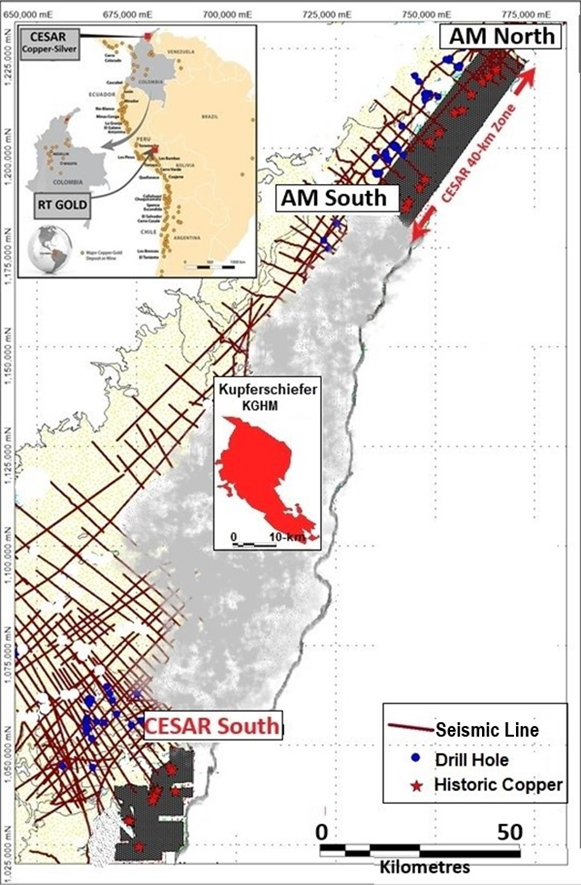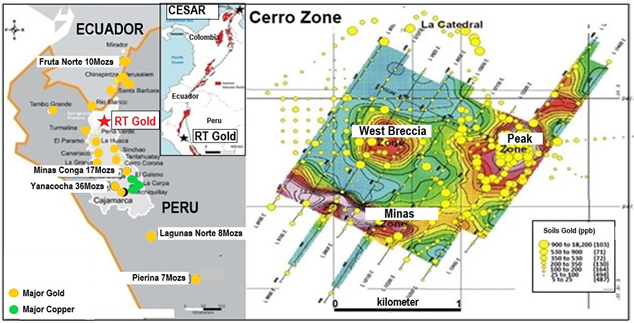Kupferschiefer Presentation at Colombia Gold Symposium Validates Similarities with Max Resource’s CESAR Project
Vancouver B.C., November 17, 2020 – MAX RESOURCE CORP. (“Max” or the “Company”) (TSX.V: MXR; OTC: MXROF; Frankfurt: M1D2) is pleased to report its recently discovered CESAR project in north eastern Colombia has been internationally recognized in a presentation titled “Stratabound/Redbed type Copper-Silver mineralization in the Cesar-Rancheria Basin, NE Colombia and the Kupferschiefer stratabound Copper-Silver deposit”.
The presentation was delivered by leading Kupferschiefer expert, Professor Adam Piestrzyński at the Colombia Gold Symposium in Medellin, Colombia, and may be viewed on the website: www.maxresource.com
Exploration conducted by Max this year, outlined continuous beds with copper-silver mineralization extending along 200-kilometres of the sedimentary basin. The similarities between Kupferschiefer and CESAR presented were: basin characteristics, lithology, mineralogy, deposit parameters, grades and, origin of sulfur. A notable difference is the Kupferschiefer orebody starting at 500-metres below surface, whereas Max’s CESAR copper-silver mineralization starts at surface (refer to Figure 1).
“We are most pleased to have our CESAR copper-silver project presented at this symposium in recognition of this important new mineral discovery in northeastern Colombia,” commented Max CEO, Brett Matich.
“Professor Piestrzyński postulated: The new discovery of sediment hosted copper-silver mineralization at CESAR could lead to the discovery of several major copper-silver occurrences, similar in size and nature to Kupferschiefer in Poland and Germany. Initial exploration by Max maybe just the tip of the iceberg,” he continued.

Figure. 1. Kupferschiefer: starts 500m below surface. CESAR: mineralization starts at surface.
The presented research presentation was authored by Prof. A. Piestrzyński, who represents University of Science and Technology, Department of Economic Geology (“AGH”), Krakow, Poland and Prof. J. Pieczonka (AGH). P. Lutynski Head Geologist of Max also contributed to the paper.
Professors at AGH have a long history of cooperation with KGHM Polska Miedz (“KGHM”), Poland’s largest copper and silver producer. The faculty’s extensive knowledge of Kupferschiefer and on-going involvement with the CESAR project, contributes significantly to project advancement and understanding of the sedimented hosted mineral system of the CESAR project.
Max believes CESAR is analogous to the Kupferschiefer. Those deposits are Europe’s largest copper source, which produced 3MT grading 1.49% copper and 48.6 g/t silver in 2018 from a mineralized zone of 0.5 to 5.5-metre thickness. Source: The Kupferschiefer Deposits and Prospects in SW Poland: Past, Present and Future by dmpi.com, September 27, 2019.
In addition, the Kupferschiefer deposits of Poland, also yielded 40Mozs of silver in 2019, almost twice the production of the world’s second largest silver mine (World Silver Survey 2020).
Max cautions investors that the presence of copper-silver mineralization at Kupferschiefer is not necessarily indicative of similar mineralization at CESAR.

Figure 2. CESAR Project location map
The CESAR project spans an area ~500sq. km in north eastern Colombia and consists of three stratabound zones: AM North, AM South and CESAR South, forming a major part of a 200-km long sediment-hosted copper-silver belt. The CESAR region enjoys major infrastructure; mining operations of Cerrejon, the largest coal mine in Latin America, jointly owned by global miners BHP Billiton, XStrata and Anglo American (refer to Figure 2).
Important highlights and exploration activity on multiple fronts:
- The AM North zone, forms an 11-km of stratabound copper-silver mineralization that is open along strike and down dip. Also contains a high-grade area with varying intervals grading 4.0 to 34.4% copper + 28 to 305 g/t silver (July 29, 2020). Bulk samples extracted from each end of the 1.8-km discovery horizon, returned 9.4% copper + 79 g/t silver and 3.5 % copper + 29 g/t silver (May 21, 2020);
- The AM South zone occurs along the same mineralized trend, 40-km SSW of the AM North zone. AM South covers an area of 4-km by 4-km, and remains open laterally. The cumulative strike length of the open-ended AM South horizons exceeds 6.4-km. Highlight values of 6.8% copper and 168 g/t silver from 0.1 to 25-metre intervals, suggesting these horizons could be of significant size (October 7, 2020);
- CESAR South, a newly acquired 340 sq. km property, copper-silver stratabound mineralization extends over at least 15-km strike length, with highlight grab sample values of 11.4% copper + 656 g/t silver;
- Fathom Geophysics is currently interpreting geophysical data funded by the Company in collaboration with one of the world's leading copper producers;
- Geochemical and mineralogical research programs by the University of Science and Technology (“AGH”) of Krakow, Poland are ongoing. AGH brings their extensive knowledge of KGHM’s world renowned Kupferschiefer sediment-hosted copper-silver deposits in Poland to the CESAR project;
- Ongoing structural analysis and seismic data interpretation of the CESAR project is being conducted by Ingeniería Geológica Universidad Nacional de Colombia (“IGUN”) in Medellín, and the Max field team;
- Max has entered into three non-exclusive confidentiality agreements regarding the CESAR project with: one of the world’s leading copper producers; a global mining company and a mid-tier copper explorer;
- Planned work: logging and XRF analysis for copper of available drill core and RC chips from historical oil and gas drilling in the western portion of the basin;
- Continue to expand the landholdings along the 200-km long CESAR copper silver belt;
- The exploration priorities for Max at CESAR project are: regional surface geochemical sampling, structural mapping, seismic data interpretation and logging of the oil-gas drill hole core chips.
RT GOLD PROPERTY – PERU
Max also holds the RT Gold property in Peru, which consists of two contiguous mineral concessions covering 1,983 hectare and sited along the Condor mountain chain of northern Peru, within the Cajamarca Metallogenic belt, 760-km NW of Lima in the District of Tabaconas. Max has rights to acquire a 100% interest by making annual payments of US$300,000 over four years and an additional US $3,000,000 payment on or before the fifth anniversary. The Vendors will retain a 2.5% NSR on the property.

Source:NI43:101 Geological Report Rio Tabaconas Gold Project for Golden Alliance Resources Corp. by George Sivertz, Oct.3, 2011
Two distinct mineralized systems occur within the RT Gold property: the Cerro Zone, a bulk tonnage gold-bearing porphyry, and 3-km to the NW, the Tablon Zone, a gold-bearing massive sulfide zone. The last field exploration was conducted almost a decade ago.
Cerro Zone
The Cerro Zone hosts several known mineralized zones (Peak, West, Breccia and Cathedral) with anomalous concentrations of gold in rock and soils:
- Structures assaying 0.1 to 62.9 g/t gold, hosted in mineralized wall rock returning gold values of 0.5 to 1.0 g/t gold;
- Soil geochemistry for gold in the Cerro Zone has outlined a 2.0-km by 1.5-km gold anomaly, open in all directions grading from 0.1 to 4.0 g/t gold;
- Soil geochemistry for gold is coincident with IP chargeability;
- The Cerro Zone has never been drill tested.
Tablon Zone
The Tablon Zone is located 3-km NW from the Cerro Zone and hosts numerous gold-bearing massive to semi-massive sulphide bodies over a 150-metre by 450-metre area, within a larger 1.0-km by 1.5-km area of anomalous gold. A total of 33 holes were diamond drilled in 2001 at Tablon with highlight intersections of:
- RT-06 returned 3.1 g/t gold over 21.4m from 9.1m;
- RT-11 returned 5.3 g/t gold over 17.1m from 12.0m;
- RT-13 returned 8.8 g/t gold over 25.4m from 13.4m;
- RT-21 returned 5.1 g/t gold over 19.5m from 1.5m;
- RT-22 returned 4.9 g/t gold over 14.1m from 40.1m;
- RT-25 returned 13.0 g/t gold over 36.1m from 33.0m;
- RT-26 returned 7.0 g/t gold over 6.0m from 0.0m;
- RT-29 returned 18.0 g/t gold over 16.4m from 34.9m, includes 118.1 g/t gold over 2.2m from 42.0m.
Intervals are core lengths not true widths, which are unknown at this time. Source: NI43:101 Geological Report Rio Tabaconas Gold Project for Golden Alliance Resources Corp. by George Sivertz, October 3, 2011.
The Max technical team is currently reviewing and digitizing proprietary data for subsequent interpretation for target generation. A program of field verification by the Max in-country team: mapping, surveying and sampling is scheduled to follow. Concurrent with the verification program, the Company will initiate drill permitting.
ABOUT MAX RESOURCE CORP.
With its successful exploration and management team, Max Resource Corp. is advancing both its stratabound Kupferschiefer type CESAR copper-silver project in Colombia and its newly acquired RT Gold, gold porphyry and massive sulfide project in Peru. Both projects have potential for the discovery of large-scale mineral deposits attractive to major partners.
Tim Henneberry, P Geo (British Columbia), a member of the Max Resource Advisory Board, is the Qualified Person who has reviewed and approved the technical content of this news release on behalf of the Company.
For more information visit: https://www.maxresource.com/
For additional information contact:
Max Resource Corp. E: info@maxresource.com
|
|
Neither TSX Venture Exchange nor its Regulation Services Provider (as that term is defined in the policies of the TSX Venture Exchange) accepts responsibility for the adequacy or accuracy of this release
Except for statements of historic fact, this news release contains certain "forward-looking information" within the meaning of applicable securities law. Forward-looking information is frequently characterized by words such as "plan", "expect", "project", "intend", "believe", "anticipate", "estimate" and other similar words, or statements that certain events or conditions "may" or "will" occur. Forward-looking statements are based on the opinions and estimates at the date the statements are made and are subject to a variety of risks and uncertainties and other factors that could cause actual events or results to differ materially from those anticipated in the forward-looking statements including, but not limited to delays or uncertainties with regulatory approvals, including that of the TSXV. There are uncertainties inherent in forward-looking information, including factors beyond the Company’s control. There are no assurances that the commercialization plans for Max Resources Corp. described in this news release will come into effect on the terms or time frame described herein. The Company undertakes no obligation to update forward-looking information if circumstances or management's estimates or opinions should change except as required by law. The reader is cautioned not to place undue reliance on forward-looking statements. Additional information identifying risks and uncertainties that could affect financial results is contained in the Company’s filings with Canadian securities regulators, which filings are available at www.sedar.com.
Back to Past News